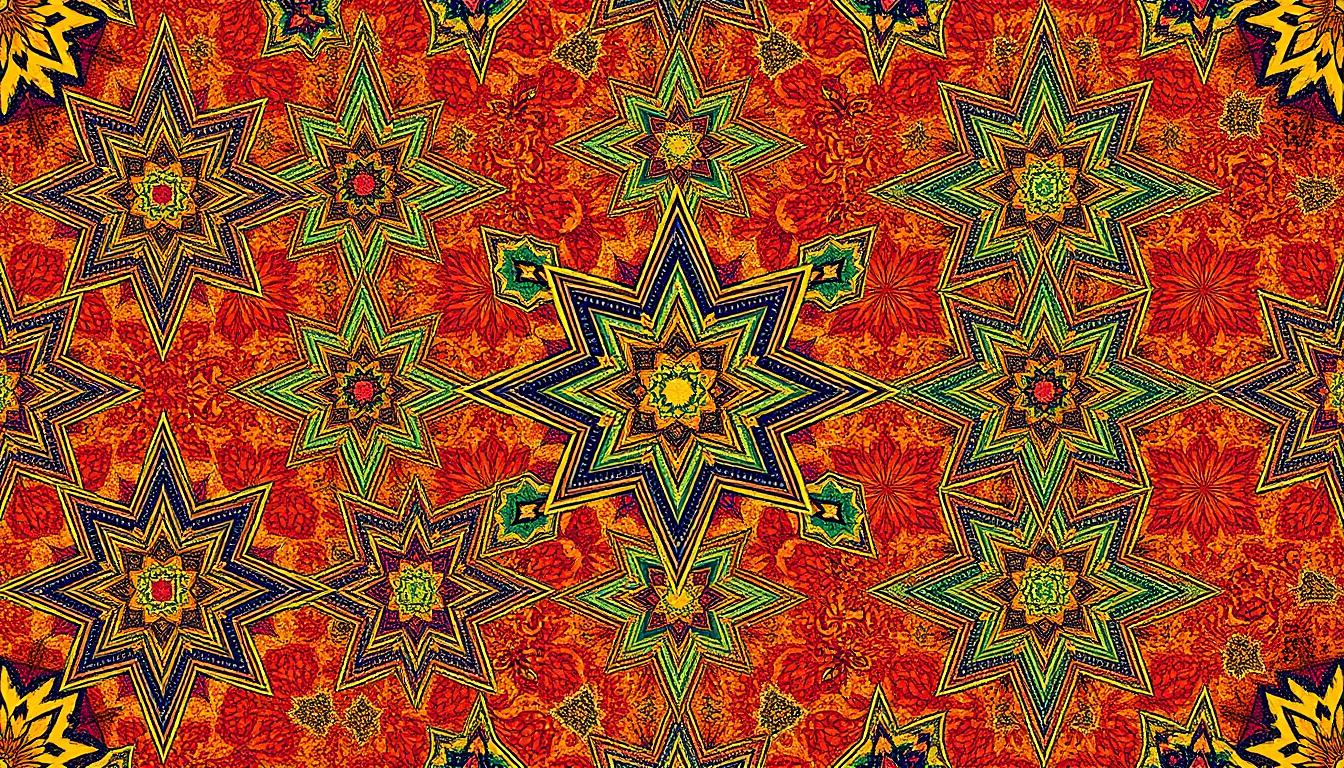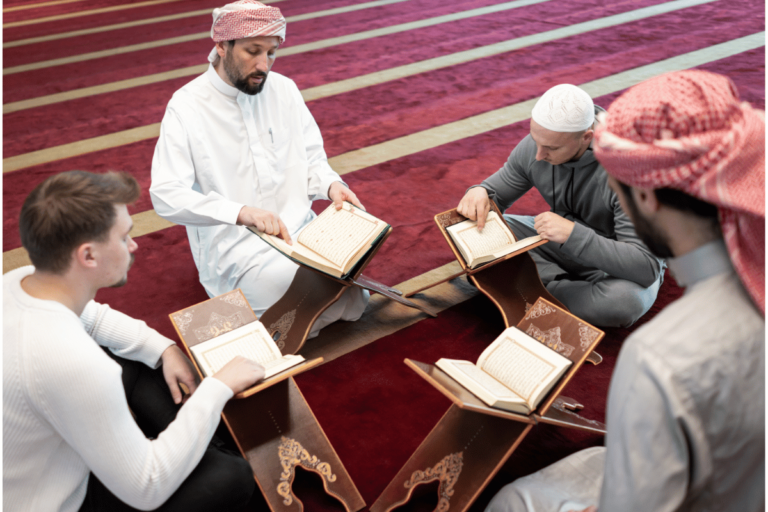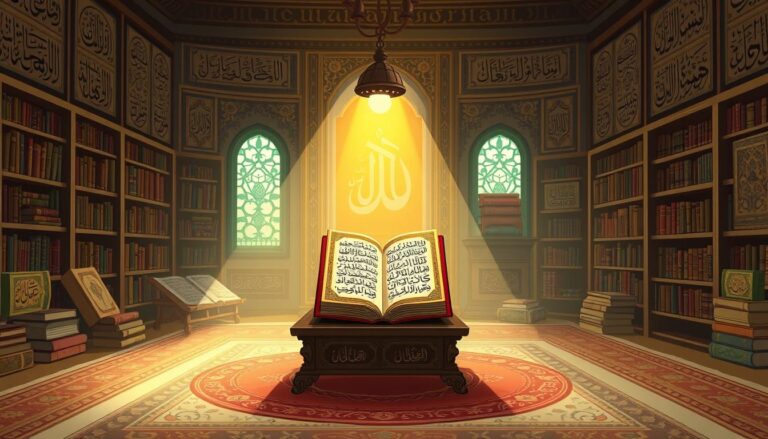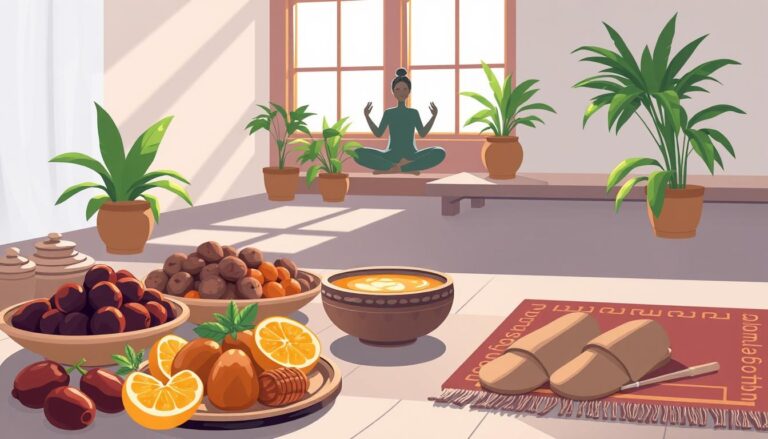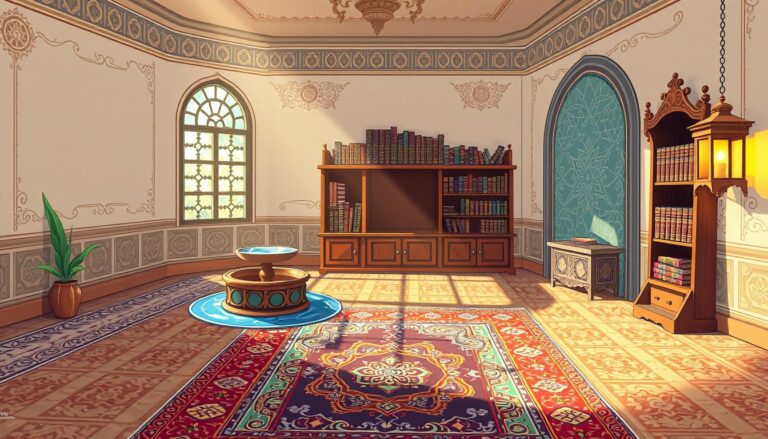Discover the Timeless Elegance of Islamic Design and Patterns
Islamic art has amazed people for centuries with its detailed patterns and lasting beauty. But have you ever thought about how these old designs still inspire today’s buildings and clothes? Let’s explore the rich history of Islamic Art and see how it shapes Middle Eastern Art and Culture.
Islamic design patterns can be found in mosques, madrasas, and palaces around the world. They show a special look based on repeated shapes. These designs, made with just a ruler and compass, show the math beauty at the heart of Islamic art.
From simple stars in the 9th century to complex 16-point stars in the 16th century, Islamic geometric patterns have grown. Yet, they keep their main ideas.
The history of Islamic art goes back to Greek geometry and designs from the late ancient times. This mix of old design ideas has led to three main types of decoration: geometric patterns, calligraphy, and vegetal patterns. Each part is key to the stunning visual mix that is Islamic art.
Today, Islamic design’s impact goes beyond old places. The Louvre Museum in Abu Dhabi, designed by Jean Nouvel, shows how Islamic patterns are used in modern buildings. Even in fashion, the traditional abaya is making a comeback, inspiring designers worldwide to mix its classic beauty with new styles.
Key Takeaways
- Islamic geometric patterns avoid figurative images, focusing on mathematical precision.
- The art form has roots in Greek geometry and late antiquity designs.
- Islamic patterns serve a spiritual purpose, connecting viewers to the infinite.
- Modern architecture, like the Louvre Abu Dhabi, incorporates Islamic design principles.
- The traditional abaya continues to influence global fashion trends.
- Islamic art features three main decorative types: geometric, calligraphic, and vegetal.
The Rich Heritage of Islamic Art
Islamic art history spans centuries, creating a beautiful and innovative tapestry. It started in the 7th century, mixing different cultures into a unique art form. Middle Eastern art and culture are at the heart of this rich heritage.
Origins and Cultural Significance
Islamic art became its own style, using geometric patterns and detailed calligraphy. These features show Islam’s spiritual values, like unity and harmony. Arabic calligraphy is seen as the pinnacle of art, carrying both literal and spiritual meanings.
Islamic Golden Age Contributions
In Baghdad’s Islamic Golden Age, artists and scholars made groundbreaking geometric designs. They used Euclidean tools, leading to big steps in math and art. Islamic mathematicians kept Greek classics alive, boosting art and science.
Influence on Western Art
The Moorish influence on Western art is clear. Islamic art ideas inspired Europeans, like M.C. Escher, known for his mind-bending art. Islamic art’s skill in tessellation shows deep understanding of geometry, shaping architectural and decorative styles globally.
- Islamic art crosses cultural lines, attracting many viewers
- Geometric patterns symbolize unity and reflect the universe’s order
- Aniconism in Islamic art emphasizes spiritual devotion over idolatry
Today, Islamic-inspired designs are found in homes, offices, and meditation spaces. They share messages of faith and unity. This lasting legacy proves Islamic art’s timeless beauty and appeal across cultures and time.
Fundamental Principles of Islamic Design
Islamic design is a rich mix of Ancient Design Principles that have lasted for centuries. It celebrates unity, order, and the beauty of geometry. Traditional Islamic Craftsmanship uses basic shapes and lines to create intricate patterns, showing the harmony of creation.
The heart of Islamic design is in its repeating patterns and lack of figurative art. These designs mix symbolism with math, finding a balance between beauty and spiritual depth. Symmetry, harmony, and rhythm in Islamic art show the unity (tawĥīd) principle, key in Islam.
Geometric patterns are key in Islamic design, found in mosques and decorative bowls. These patterns include circles, squares, stars, and polygons, sometimes with plant motifs like the acanthus. The star symbolizes spiritual enlightenment and guidance in prayer.
- Arabesque: Intricate interlocking plant motifs and geometric shapes
- Tessellation: Repeating geometric shapes without gaps or overlaps
- Calligraphy: The art of beautiful writing, often integrated with other design elements
Islamic geometric art’s popularity in modern design shows its lasting appeal. Today’s artists and designers find inspiration in these timeless patterns. This keeps the legacy of Traditional Islamic Craftsmanship alive in our world.
Geometric Patterns in Islamic Architecture
Geometric patterns are at the core of Islamic architecture. They show the deep heritage of Middle Eastern art and culture. These detailed designs, made from math and art, have decorated mosques, palaces, and cultural spots for over a thousand years.
The Role of Mathematics in Islamic Art
Islamic artists in Baghdad used Euclidean tools to create stunning geometric patterns. During the Islamic Golden Age (8th to 14th centuries), mathematicians like Al-Khwarizmi and Al-Haytham set the stage for these complex designs. Their work still inspires architects and designers today.
Symbolism in Geometric Designs
Geometric patterns in Islamic architecture often include eightfold stars and symmetrical motifs. These designs symbolize unity, harmony, and the infinite nature of the divine. The repeating patterns remind us of the vast universe and Allah’s eternal presence.
Famous Architectural Examples
The Blue Mosque in Istanbul and the Alhambra in Granada showcase the beauty of Islamic geometric patterns. The Alhambra Palace, with its 13th and 14th-century tilework, is a masterpiece. Ottoman architect Mimar Sinan, known as the “Euclid of Ottomans,” designed over 300 structures with intricate geometric patterns, including the famous Suleymaniye mosque.
“Islamic geometric patterns have a universal appeal that transcends time and culture, found from Spain to Uzbekistan.”
Today, these timeless designs still shape modern architecture and interior decor. They connect ancient wisdom with modern beauty.
Arabesque Motifs: Nature-Inspired Elegance
Arabesque motifs show the beauty of nature in Islamic art. They feature intertwining leaves, flowers, and vines. This style mixes geometric shapes with organic forms, creating a balance that draws the eye.
These patterns have a long history, found in many cultures. In Islamic countries, they decorate buildings, ceramics, and fabrics. Similar designs in Asian art, like “karakusa” in Japan and “ruyi” in China, also symbolize good luck.
In Islamic architecture, Arabesque patterns are key. The Taq-e Bostan in Iran has rock reliefs with these designs. They turn mosques and palaces into stunning works of art.
“Arabesque art emerged in the Islamic era and is characterized by intricate interlacing patterns of vines, leaves, and geometric shapes.”
Today, Arabesque motifs inspire artists and designers globally. You can see them in jewelry, home decor, and modern buildings. Arabesque tiles, made from ceramic, glass, and stone, are used in kitchens, bathrooms, and outdoors.
The lasting appeal of Arabesque motifs shows their timeless beauty and the skill of Islamic craftsmanship. Appreciating these designs connects us to centuries of art and the beauty of nature.
Calligraphy: The Art of Beautiful Writing
Calligraphy is a key part of Middle Eastern art and culture. It turns letters into beautiful works of art. Islamic calligraphy, with its long history, is especially notable.
Quranic Calligraphy
The Quran is central to Islamic calligraphy. Early Qurans had uniform letters, like Prophet Muhammad’s seal. The Kufic script, from Kufa, Iraq, was used until the 11th century.
Styles and Techniques
Islamic calligraphy has many styles. The Thuluth script, created by Ibn Muqla in 930 AD, is famous for its curved letters. Other styles include:
- Naskh: A rounded, easy-to-read script for body text
- Muhaqqaq: A grand script for large Qurans
- Copperplate: A style with fine lines, influenced by the West
Integration with Other Design Elements
Calligraphy often mixes with other Islamic art. Geometric patterns and arabesque motifs add to the beauty. This blend is seen in places like the Taj Mahal and Topkapı Palace.
Today, calligraphy workshops are popular. People learn this ancient art for various uses, from wedding invites to logos. It connects old traditions with new designs.
Islamic Tilework: A Symphony of Colors and Patterns
Islamic tilework is a stunning display of intricate designs and calligraphy. It turns walls, floors, and domes into stunning visuals. It mixes geometric shapes with flowers and calligraphy.
The history of Islamic tilework is long and wide. The Great Mosque of Kairouan in Tunisia is from the 7th century. It shows early examples of this art. The Dome of the Rock in Jerusalem, built in the late 7th century, has beautiful mosaics that have inspired many.
Zellige is a mosaic tilework known for Moroccan design. Artisans carefully cut each tile for intricate patterns. These designs reflect the Maghreb region’s culture and are found in both sacred and secular places.
“Islamic tilework is a living art form, evolving while staying true to its roots.”
The Sheikh Zayed Grand Mosque in Abu Dhabi is a modern example. Built in the early 21st century, it mixes old and new. Its walls and domes show off tilework and calligraphy beautifully.
Islamic tilework is known for its variety and beauty. From Turkish Iznik tiles to Moroccan Zellige, it amazes everyone. It reminds us of the artistic traditions that have shaped Islamic culture for over a thousand years.
Discover the Timeless Elegance of Islamic Design and Patterns
Islamic design and patterns have amazed people for over a thousand years. Their beauty is found throughout the Islamic world and still inspires artists today. Let’s dive into the lasting charm of this art and its global reach.
Enduring Appeal Across Centuries
Islamic art history is a mix of geometric precision and detailed calligraphy. The use of black and white as main colors started in the 7th century. Black stands for ultimate reality, and white for purity and spirituality.
This color scheme has shaped many artistic forms, from buildings to fabrics.
Modern Interpretations of Traditional Designs
Today, artists and designers find inspiration in Islamic art’s timeless beauty. They mix geometric patterns and calligraphy into modern pieces. These new takes keep the tradition alive while bringing fresh views.
Islamic-inspired designs are now seen in fashion, graphic design, and architecture all over the world.
Global Appreciation of Islamic Art
The love for Islamic art is clear in its display in big museums. People from different cultures enjoy its beauty and complexity. Islamic design’s focus on harmony, balance, and symbolism connects with people everywhere.
This art is key in keeping cultural heritage alive and promoting understanding between cultures.
“Islamic art is a testament to the power of beauty to transcend time and culture.”
Exploring Islamic design and patterns shows how this rich tradition continues to inspire and unite people globally.
The Alhambra: A Masterpiece of Islamic Design
The Alhambra Palace in Granada, Spain is a stunning example of Islamic art and architecture. Built in 889 AD, it was later turned into a royal palace. This UNESCO World Heritage Site is the peak of Moorish influence on Western art.
The Alhambra covers 35 acres and is filled with intricate geometric patterns. Its design combines Islamic artistic traditions with local styles. This unique look has inspired many artists and architects for centuries.
The palace shows off incredible Islamic craftsmanship:
- Arabesques and muqarnas
- Calligraphy and courtyards
- Stucco reliefs and wood carvings
- Ceramic tiles with intricate mosaic patterns
The Alhambra’s beauty comes from its mix of art and function. The Lion’s Courtyard, with its detailed custard stone lions, is a perfect example. Its mesmerizing ceilings, clever use of light, and symmetrical design make it a masterpiece.
“The Alhambra is a symphony of geometry, light, and water that captivates the senses and stirs the soul.”
Today, the Alhambra faces challenges due to many visitors. Strict rules and help from UNESCO and the World Monuments Fund protect it. This ensures it remains a wonder of Moorish influence for future generations.
Islamic Design in Contemporary Art and Architecture
The beauty of Islamic design and patterns still inspires artists and architects today. This tradition from the Middle East has grown, mixing old styles with new ideas. Now, we see a blend of old and new, creating spaces that respect history and welcome the future.
Fusion of Traditional and Modern Aesthetics
Designers are now using modern materials to bring Islamic architectural elements to life. Glass, steel, and concrete join traditional marble and ceramic tiles. This mix creates amazing spaces that are both authentic and modern. For instance, Algedra Interior Design combines traditional Islamic designs with today’s styles, keeping their cultural value.
Notable Contemporary Islamic Artists
Today’s artists are giving Islamic art a fresh look. They’re using digital tools and mixed materials to reimagine classic patterns and calligraphy. This shows how Islamic design stays relevant and appealing to people all over the world.
Islamic-Inspired Design in Global Architecture
Islamic-inspired designs are found in buildings all over the world, from museums to airports. Architects use symbols like domes and arches in new ways. They also use Islamic design’s rich colors, like deep blues and greens, in their work. This global interest helps us see the beauty of Islamic design and patterns, connecting cultures and times through art.
Source Links
- Traditional Abaya: Timeless Elegance in Islamic Fashion
- Islamic geometric patterns
- Sustainability Implications of Utilizing Islamic Geometric Patterns in Contemporary Designs, a Systematic Analysis
- Introduction to Islamic Architecture: A Celebration of Divine Aesthetics
- Islamic Art Facts for Kids: Fascinating Facts and Creative Activities
- Islamic Wall Decor (AM2309) – unitedtreesupply.com
- The Silent Theology of Islamic Art
- Islamic Geometric Patterns + Names And Meaning | 2024
- Islamic Geometric Patterns | Paris Tile
- The Stunning Beauty of Islamic Geometry
- The hidden beauty of the arabesque pattern – Men’s Platinum Jewelry | ByEnzo
- Islimi Khataei Floral Art Motif | Arabesque Art And Patterns
- Important Facts about Arabesque Tile
- The Art of Islamic Patterns
- My Journey in Arabic Calligraphy & Geometric Patterns in Islamic Art – SagaTeller
- The Art of Elegance: Exploring the Timeless Beauty of Calligraphy
- The Most Captivating Islamic Architectural Wonders Around the Region
- Ephemeral Elegance: The Beauty of Traditional Moroccan Crafts – Raoyfah
- Black and white Islamic art: Discover the Elegance
- Top 5 Islamic Art Wall Ideas Revealed
- The Alhambra: A Testament to Moorish Splendor – Water Shapes
- Alhambra Architecture: Style & Techniques
- Islamic Art and Architecture – Explore | Yatra – e – Hind
- Algedra

